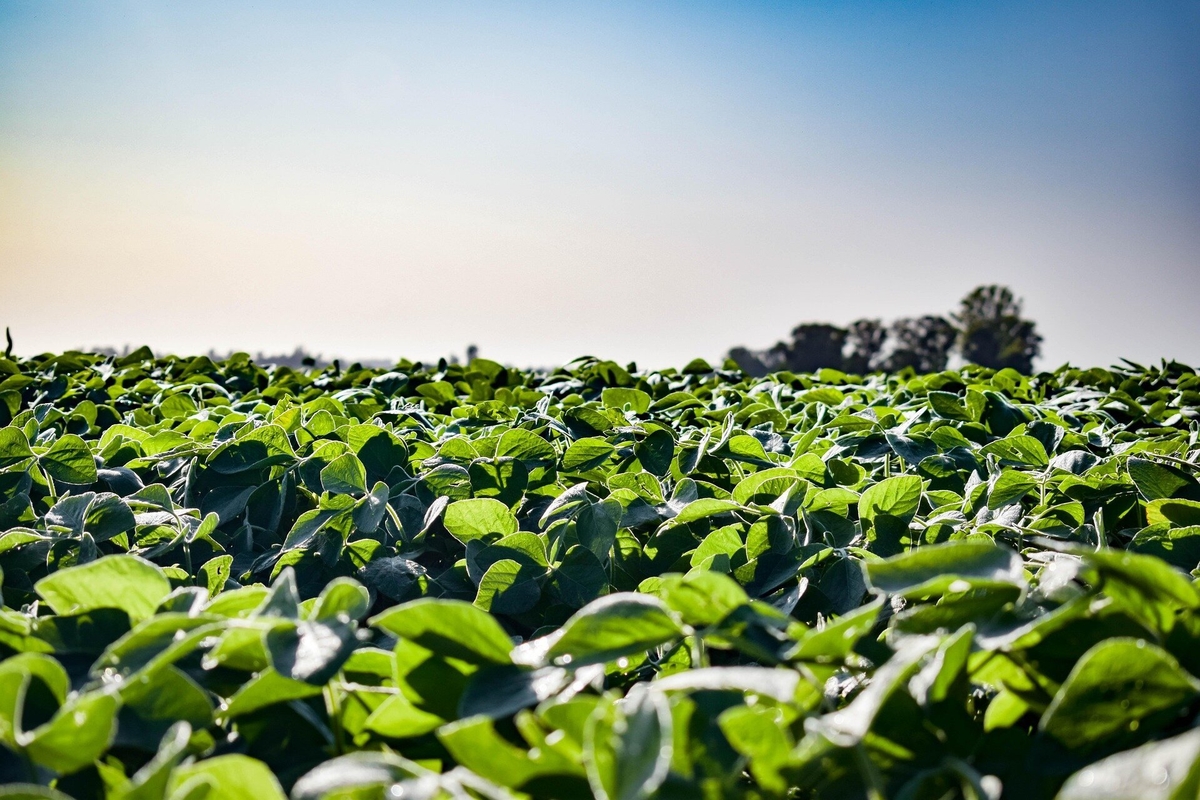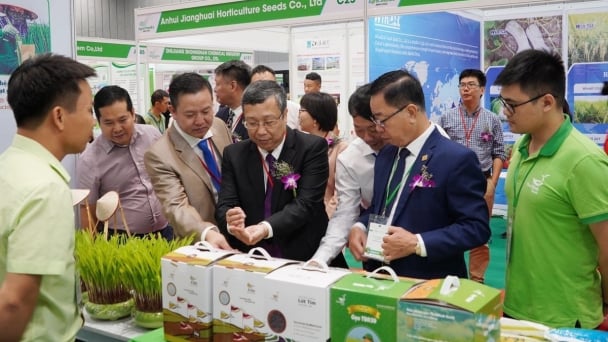June 27, 2025 | 15:06 GMT +7
June 27, 2025 | 15:06 GMT +7
Hotline: 0913.378.918
June 27, 2025 | 15:06 GMT +7
Hotline: 0913.378.918

Tillage reductions lead to dramatic rise in crop yields and soil organic carbon levels. Photo: Phys.org.
Corn and soybean yields have increased dramatically since 2000, according to a new study from South Dakota State University's Department of Agronomy, Horticulture and Plant Science. In South Dakota, Iowa, Minnesota and Nebraska, corn yields are increasing at over two bushels per acre per year, and soybean yields are increasing at over half a bushel per acre per year.
While improved crop varieties have contributed to yield increases, improvements in soil health, resulting from the adoption of conservation practices like reduced or no-tillage, have also contributed. The study reveals soil organic matter levels are increasing at a rate of over 650 pounds per acre per year. Higher levels of soil organic matter greatly contribute to improved soil health.
According to Deepak Joshi, a graduate of SDSU and now an assistant professor at Kansas State University, and David Clay, Distinguished Professor of soil science at SDSU, the findings from this study suggest the combined impact of improved genetics, reduced tillage intensity and increased adoption of other conservation practices, and greater soil water-holding capacity has resulted in higher—and increasing—annual corn and soybean yields.
In the 1800s, South Dakota's prairies were first being homesteaded as settlers arrived from the east. Then, farmers used a moldboard plow to turn over and aerate the soil. This process, known as "tillage" or "tilling," helps control weeds and prepares the soil for seeding. While this method was successful in growing crops for the region, it also led to challenges and, eventually, disaster. The Dust Bowl—arguably the greatest ecological catastrophe in modern history—was partly caused by the destruction of native prairie grasses and the overtilling of precious, fertile topsoil.
The intense, widespread tillage practices also led to historically low levels of soil organic carbon. Eventually, scientists learned that soil organic carbon—a measurable component of the organic matter found in the soil—plays a key role in soil health. Carbon is a major component of organic matter and contributes to nutrient retention, soil structure and soil water storage—crucial elements for producing high yields.
As scientists and farmers began to better understand the relationship between tillage and soil organic carbon, farming practices began to change. From the 1980s onward, tillage intensities gradually decreased, first to conservation tillage systems and then to no-tillage systems.
Surveys conducted between 1985 and 2010 found that in the Great Plains, farmers rapidly adopted no-tillage systems as it increased soil water storage and improved their crop's profitability. By 2012, no-tillage was used on approximately 33% of U.S. farms. A survey conducted between 2018 and 2021 found 77% of eastern South Dakota farmers used some form of reduced tillage system.
It became clear that a comprehensive study was needed to better understand the relationship between soil organic carbon levels, tillage reductions and yields. Clay and his research team analyzed data over a 21-year period (2000-2021) in their pivotal study, titled "Tillage intensity reductions when combined with yield increases may slow carbon saturation in the central United States," published in Scientific Reports.
Utilizing over 650,000 surface soil samples from South Dakota over a 21-year period, the team of researchers determined that on a yearly basis, 428 pounds of carbon per acre were being stored annually in South Dakota's fields.
"Based on over 12 million soil samples collected from South Dakota, Minnesota, Iowa and Nebraska, we determined that approximately 1.24 billion metric tons of carbon were stored in the six inches of surface soil over the 21-year period," Clay said. "In addition to the large amount of carbon that was stored, improvements in soil health most likely contributed to the reduction of sheet and rill erosion, which decreased by 22.8%, 14.3%, 27.5% and 31.5% between 1987 to 2017 in Nebraska, Iowa, Minnesota and South Dakota, respectively.
"There is a linkage between tillage reductions, yield increases and erosion," Clay continued. "Tillage intensity reductions slows soil organic matter decomposition, which increases the ability of the soil to retain water, leading to improved yields. Higher yields lead to soil organic matter increases, which further increases productivity while reducing both runoff and erosion."
The increasing levels of soil organic carbon can be attributed to greater residue, like corn stover, corn root and corn exudates, that remains in the field following harvest. This material, known as nonharvested carbon, is decomposed by organisms in the soil and converted into humus—dark, organic material that forms when plant matter decays. Humus provides many benefits to the soil and is measured by researchers as soil organic matter.
The study emphasizes one key point: higher yields are a result of several factors, including improved genetics and soil health. As Clay notes, it is clear that these factors work in tandem to produce a feedback loop that is increasing soil organic matter and, in turn, boosting yields. Each year, the loop continues forward, simultaneously increasing soil organic matter levels and yields.
Is there a point where there is too much carbon in the soil? This concept, known as carbon saturation, suggests there is a limit to the amount of organic carbon that can be stored in the soil. Once the soil's limit is reached, it's possible that additional increases in soil organic matter would not occur.
According to Clay's research, South Dakota's soils are not yet approaching carbon saturation.
"These findings also suggest that Nebraska, Iowa, Minnesota and South Dakota soil may be able to store more carbon as tillage intensities continue to decrease and cover crops—an additional source of nonharvested carbon—are more fully integrated into production systems," Clay added.
The increase in soil organic carbon levels in South Dakota fields may mean farmers do not need to use as much nitrogen in their corn fields, Clay believes.
In 2024, a team of researchers, including SDSU research associate Dwarika Bhattarai, David Clay, Sharon Clay, SDSU graduate research assistants Shailesh Pandit and Rojina Kafle, SDSU professor Thandi Nleya and SDSU assistant professor and Extension soil fertility specialist Jason Clark, reported that in South Dakota, nitrogen recommendations can be reduced by approximately 25% without reducing corn yields.
Clay partially attributes the nitrogen reduction rate to improved soil health, leading to enhanced nitrogen use efficiency. Currently, this team is working to better understand the relationship between soil organic carbon increases and nitrogen recommendation decreases.
They also believe the increase in soil organic carbon levels is linked to better resilience against extreme weather events. Because high levels of soil organic carbon help improve water storage capacity, the resiliency of South Dakota's soils has increased, allowing them to better handle droughts. This is evidenced by previous research, which compared the economic impact of the 1974 and 2012 droughts in South Dakota.
This work showed that improved soil health contributed to a $1.1 billion economic impact on South Dakota's net agriculture returns during the 2012 drought—despite 2012 being a more severe drought year than 1974.
(Phys.org)

(VAN) Vietnam and China are strengthening connectivity and cooperation in the field of crop varieties and agricultural materials, paving the way for sustainable development in the agricultural sectors of both countries.

(VAN) Over the past 20 years, Hai Phong has reduced the number of bears in captivity from 500 to just over 10, thanks to the efforts of the forest protection force.

(VAN) Prime Minister Pham Minh Chinh held talks with Chinese Premier Li Qiang on June 24, in Tianjin, China.

(VAN) On the occasion of attending the World Economic Forum (WEF) in Tianjin, China, on the morning of June 25 (local time), Prime Minister Pham Minh Chinh met with Senegalese Prime Minister Ousmane Sonko.

(VAN) The Net Zero door is opening, but no one can walk through it if they stay outside the mandatory emissions inventory roadmap starting in 2025.

(VAN) The visit to China Agricultural University opens up new prospects for high-tech agricultural cooperation, fostering connections between research institutes and enterprises of Vietnam - China.

(VAN) Con Dao, the emerald gem in the vast ocean, is undergoing a powerful revival, transforming into one of Vietnam’s leading ‘eco-spiritual paradises.’ In this journey.